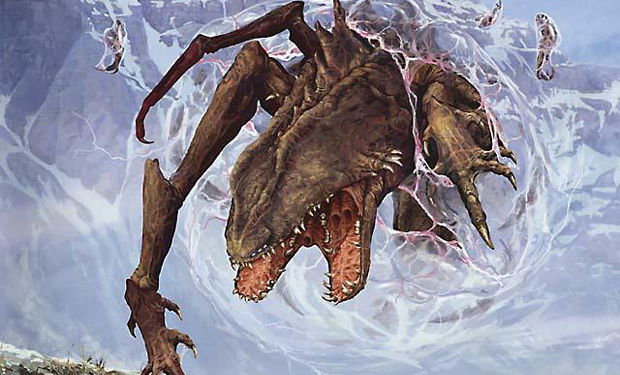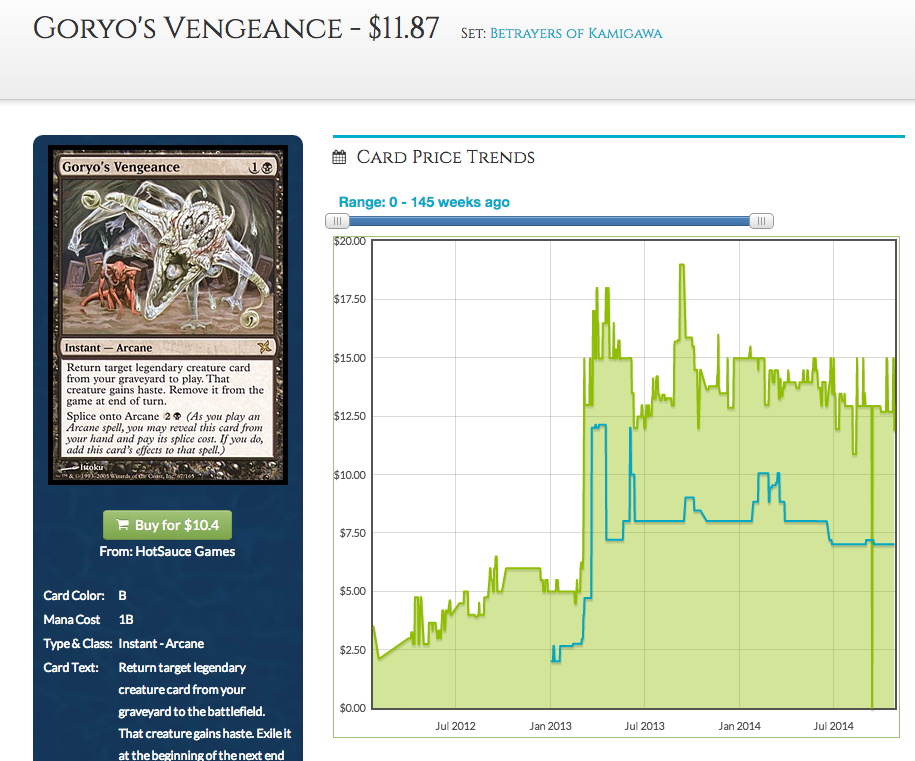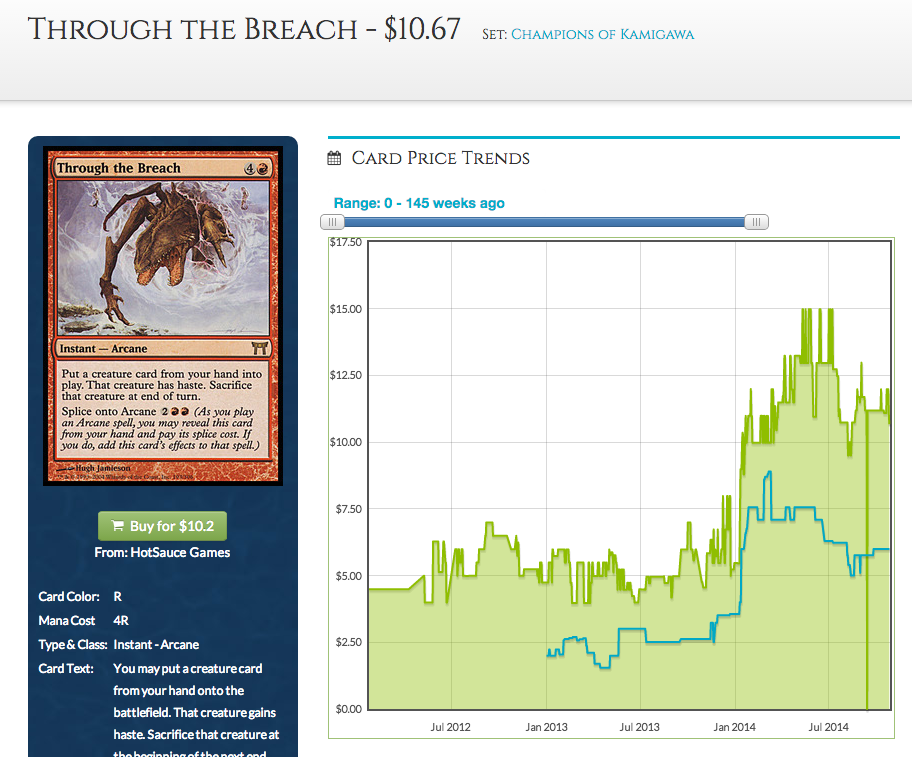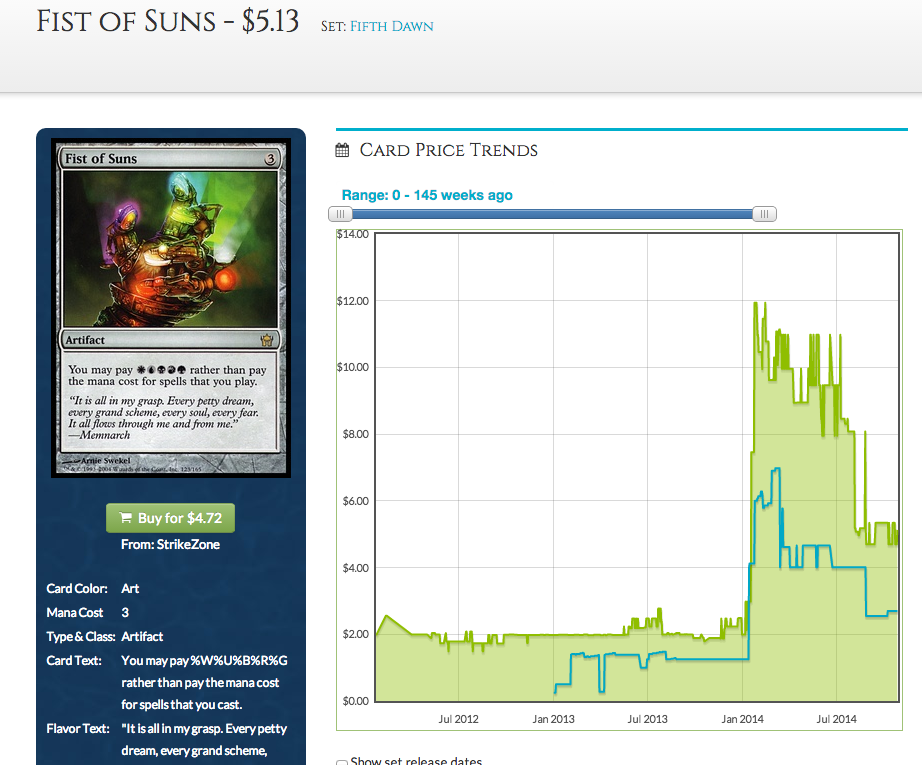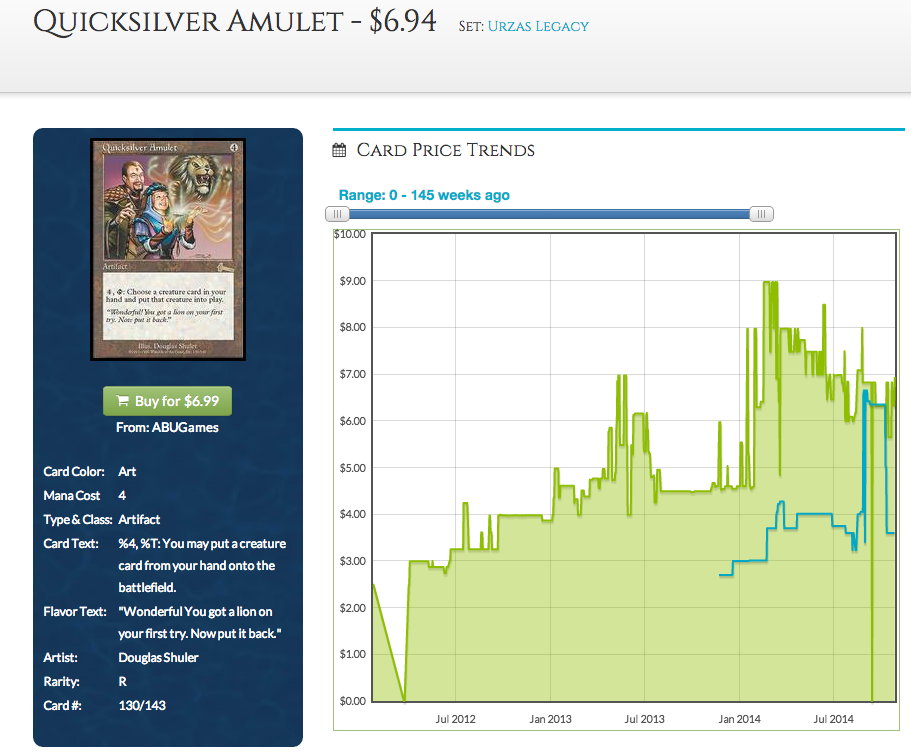By: Guo Heng Chin
Have you heard of the new turn 2 kill in Modern? Well, the Narset Combo deck is probably not news to most of you anymore. But for those who haven’t heard of it, it is a deck that exploits Goryo’s Vengeance to cheat in the hexproof Narset, Enlightened Master and chain a series of attack phases which results in Enter the Infinite and Omniscience being ‘casted’ with Narset’s ability. It is a Johnny masterpiece designed by Gabriel Jones who handed the list to Travis Woo for maximum exposure. You can read more about it and see it in action here.
The Narset deck may be a bit too wombo combo to be tier one, but it reminded me of a theory proposed by a friend and fellow Magic finance enthusiast about Goryo’s Vengeance while we were discussing if it was worth investing in our own playset of Goryo’s Vengeance:
Goryo’s Vengeance gets better as more legendary creatures are printed.
Back then in 2012, when we bought our playsets of Goryo’s Vengeance, it was a $4 card.
Today I am going to discuss how the theory could apply to other cards in similar veins to Goryo’s Vengeance, cards that allows you to cheat-in creatures. This is the Increasing Savagery theory and credit goes to Reza Baharin (@rezaaba on Twitter) for coming up with it. The theory is named after Dark Ascension’s Increasing cycle of cards that get more powerful as the game progresses; likewise the cards the theory attempts to explain increase in potential as more Magic sets are released.
A Lannister Always Pays His Casting Cost. That Doesn’t Means You Must.
Magic is an ever-growing, ever-changing game. When I first started Magic back in the late 90s, a four casting cost 5/5 creature came with a drawback, your opponent’s lands were legit targets and spells were king. In 2014, we have a four mana 5/5 creature with added gatling gun and the majority of Standard archetypes are creature-centric. Meddling with your opponent’s mana base is a no-no, because allegedly land-sadists are in the minority.
Through the years, Wizard’s design paradigm shifted towards encouraging interactivity and board-based game states and creatures are bestowed with a higher power level than those of Magic of yore. Regardless of the changes in Magic’s design priorities, one aspect remained the same throughout Magic’s design history: there are always splashy creatures.
Splashy creatures are monsters that shout ‘Wow!’, be it because they are a big flying spaghetti monster, or they possess some insanely cool ability (double cascade anybody). Splashy creatures usually come with a prohibitive mana cost, for great power is a reward deserved only by those who goes through the pain of assembling the required mana.
Or to those who prefer sneakier methods.
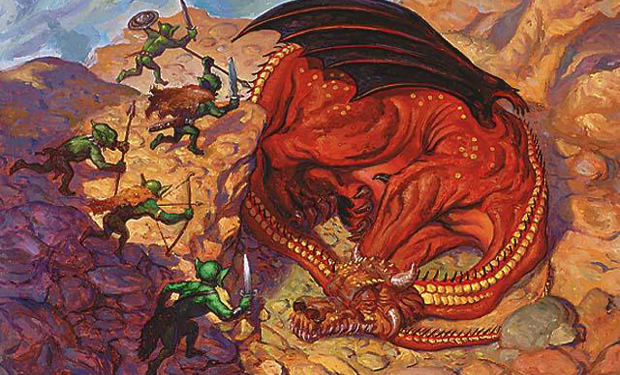
From Lord of the Pit of the days of yore to Eldrazis of today, splashy creatures remain the mainstay of Magic. Their sheer size makes Timmies shudder with excitement, their unique abilities rev up the brew engine of Johnnies and occasionally, reaches through the breach from kitchen table play to the competitive tables of Spikes.
Legendary creatures add to the lot as well. While Wizards does not specifically design legendary creatures in normal sets to appeal to Commander players, legendary creatures are designed to be cool. Plus, the legend rule allows Wizards to push the power level of legendary creature. Characters in Magic’s storyline manifest themselves in cardboard form as legendary creatures or Planeswalkers, and as every Magic set comes with a story, it is a pretty safe assumption that most sets will contain legendary creatures.
Thus the first premise of the Increasing Savagery Theory: the number of splashy and/or legendary creatures increases with the number of Magic sets.
The next premise the theory rests on is that Wizards’ design and development teams are continually inclined to push boundaries for creatures they design, so as to keep players excited for new cards. Sometimes this manifested itself as an undercosted creature. Other times this manifest itself as a creature with an awesome ability counteracted by a prohibitive casting cost, a la Emrakul, the Aeons Torn, Griselbrand and Avacyn, Angel of Hope.
So we can also safely assume that we will continue to see powerful creatures with prohibitive mana costs and this forms the second premise of the Increasing Savagery Theory.
The third premise is pretty straightforward: cards like Goryo’s Vengeance and Through the Breach are only as good as the fatties you can cheat into play with them.
Put all three premises together and you get:
Cards that allow you to circumvent a creature’s casting cost gets better as more Magic sets are released.
Counter Arguments
The counter argument to this theory is that new big game-breaking creatures will displace the current targets for the cheat cards, making the demand for cheat-into-play cards remain relatively stable. Those decklists are tight, and there is no reason to play the old fatties if the new ones are strictly better.
While it is true that better win condition targets would replace the incumbents, the replacement itself could potentially bolster the existing archetype. Prior to Griselbrand, Legacy Sneak and Show decks were running Progenitus alongside Emrakul as Show and Tell fodder five to seven. While Emrakul is susceptible to Jace, the Mind Sculptor and Progenitus to board wipe, Griselbrand provided a strict upgrade to the deck as the big bad demon technically possesses an ETB ability as he grants an extra seven to fourteen cards upon touching the board.
While Show and Tell was already an expensive card at $40 prior to the adoption of Griselbrand, it spiked to mid-$60s in July 2012 when four-of Griselbrands propelled Sneak and Show decks to the next level.
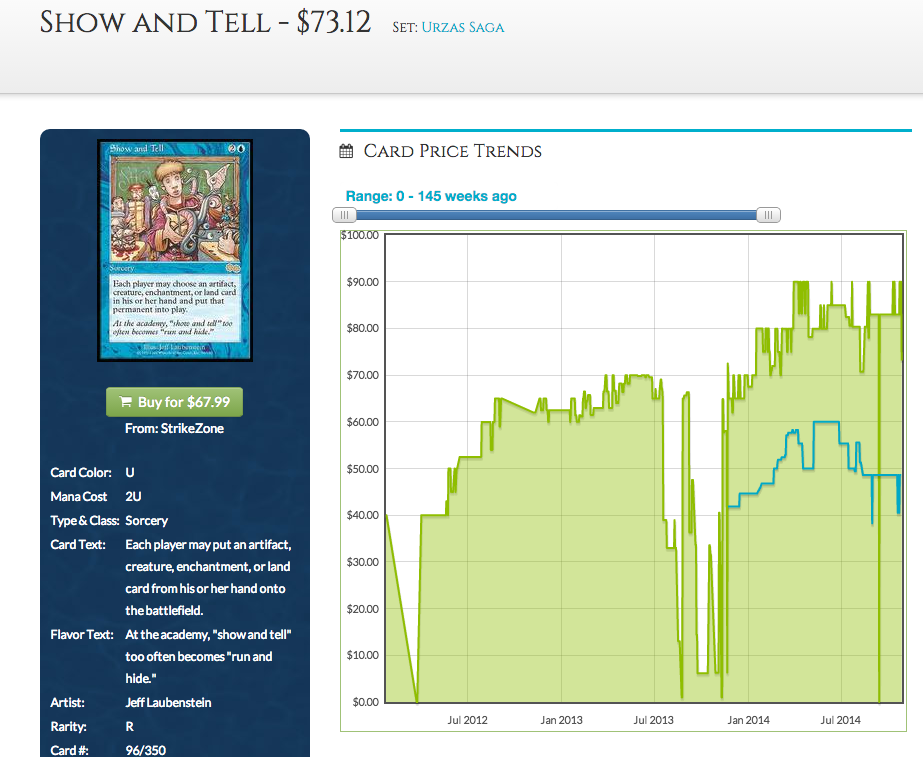
Modern Goryo decks could benefit if a more efficient fatty were to be printed in the future. Say a fatty that comes with a game-breaking enter-the-battlefield ability that does not require you to pay seven life. Modern players take a lot more damage from their manabase compared to Legacy players and sometimes cheating a Griselbrand into play is not enough to turn the board around. Perhaps the a new splashy creature were to be printed that conveniently stays in the graveyard for reanimation purposes. Perhaps a new fatty negates the need for Fury of the Horde as a win condition, freeing up four slots in the deck for cards to improve the deck’s resilience.
The other counter argument is that the Achilles heel of Modern Goryo decks is the decks’ susceptibility to discard and countermagic rather than a lack of creatures to cheat into play. That is an issue that the printing of new fatties would not shore, but the printing of new spells might. For example, the addition of Izzet Charm injected an extra dose of consistency into the Griselbrand Reanimator by giving it more dig spells, discard outlet and counter protection.
Furthermore, new fatties or legendaries could instigate new archetypes or twists on existing archetypes; both could potentially increase demand for the cheat-into-play cards that are key to making those decks work. A breakthrough or a bust, the Narset Combo deck supports the Increasing Savagery theory in that it creates another deck that relies on Goryo’s Vengeance. Who knows, perhaps sometime in the near future, a Todd Anderson might pilot a tuned Narset Combo into 11th place at a Grand Prix, or a Jan van der Vegt might add on a few copies of an old, forgotten card and make that deck the talk of the Grand Prix.
Now to the Financial Side
While there are a plethora of cards that allows you to circumvent pesky casting costs, the cards I am going to discuss in this article are cards that are themselves costed low enough to be considered cheating a creature into play (sorry Omniscience, Tooth and Nail) and is not too conditional (sorry Summoning Trap), and Modern-legal (the Legacy ship for cards in this category has long sailed, adios Show and Tell!).
That leaves us with pretty much the cards that are used in the various incarnations of Modern Griselbrand Reanimator: Goryo’s Vengeance, Through the Breach and Fist of Suns. And the oft-overlooked Quicksilver Amulet.
Pros: The card that inspired the Increasing Savagery theory and one of the most powerful cards in Modern, Goryo’s act of revenge is the reason why Modern Reanimator decks can execute turn two kills. It is key to the archetype and is likely to be the first card brewers turn to when a new splashy legendary creature is spoiled.
The card contains “Goryo” in its name, is an Arcane spell and Champions of Kamigawa’s popularity mean Goryo is probably not coming back for a vengeance anytime soon.
Cons: Goryo’s Vengeance is the cheat-into-play candidate with the highest chance meeting the banhammer. It also has a pretty hefty price tag at $11. Goryo’s price didn’t really sink the way Fist of Suns’ did when the deck that ran them didn’t top 8 the Grand Prix they were causing so much furore at.
Pros: Through the Breach has a flavor-tied name and is also an Arcane spell, giving it a low chance of being reprinted. It is also ran as a two-of in Legacy Sneak and Show sideboards, which could be another factor pushing its price.
Cons: Like Goryo’s Vengeance, Through the Breach is not exactly cheap to buy in at $11. Well, at least its unlikely to face the hammer anytime soon, so its got that goin’ for it, which is nice.
Pros: $5 is a pretty good buy in after its precipitous drop from $12. Fist of Suns is a card that is begging to be broken. It ‘casts’ your fatty as well, so brownie points for synergy with Emrakul.
Cons: Fist is more vulnerable compared with Goryo’s Vengeance and Through the Breach, mainly because you don’t often cast Fist of Suns and use its ability on the same turn, making it susceptible to artifact removal. Plus resolving a Fist does not guarantee the resolution of your beast. Unless it’s Emrakul.
And you’ll need all your colors to abuse this one.
Pros: Featured in the latest iteration of Griselbrand Reanimator by Tatsushi Tsukamoto who finished 23rd in the recent Grand Prix Kobe. It is the only truly colorless route to summon a creature without paying the creature’s mana cost. The amulet is currently at $7 and is slowly trending up.
Cons: Probably the weakest cheat card of all the cheat-into-play cards. The Amulet does not grants haste (though you could technically drop the creature at the end of your opponent’s turn) nor does it casts the card, thus missing out on Emrakul’s Time Walk trigger. Quicksilver Amulet also does not see much Commander play. Amulet it may be, but with two printings, this card may not have much room to grow. Nevertheless, I am still surprised to see this once bulkish rare trending at $7.
The Supreme Verdict
The cards that subscribe to the Increasing Savagery theory are long-term investment targets rather than fodder for quick speculation. We do not know when the next innovative tech will emerge to trigger another spike in the price of those cards, but we know that every new set adds to the chance of a breakthrough innovation happening. The Modern cheat-creatures-into-play archetype is one breakthrough away from being tier one.
Goryo’s Vengeance and Through the Breach at $11 are steep, however those cards are likely to increase in value over time as more fatties and legendary creatures enter the card pool. Securing your own playset of those cards now would seem prescient when their next spike comes with the next breakthrough tech. They are cards you could probably take your time to amass rather than going all out right on acquisition now. I would prefer to trade for them rather than buy them outright.
While I am comfortable holding Through the Breach for a long time, I would be inclined to sell Goryo’s Vengeance the next time it spikes. Goryo’s power level is sitting on the borderline of bannable and shall the next iteration of Goryo decks prove to be more resilient than the current lists, the next spike might just be Goryo’s last. Taking a leaf off Travis Allen’s recent article, being too greedy might just result in missing the Treasure Cruise.
If there are any cards on the veins of the Increasing Savagery theory that is worth buying now, it would be Fist of Suns at the paltry $5 it is valued at as of writing. It is a card that is begging to be broken, plus unlike the rest of the Increasing Savagery cards, Fist of Suns could cheat in any spell. Any spell.
While Quicksilver Amulet is just $7 and is gradually climbing in value, I am skeptical about picking it as a good target mainly because it sees little to no play in Modern and casual formats and has multiple printings.
Bonus
Wizards designs cards to synergise with upcoming sets. Mutavault in M14 supported mono-colored Devotion strategies in Theros, and Courser of Kruphix in Born of the Gods works in tandem with Khans of Tarkir fetchlands.
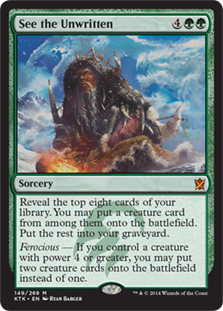
Could you see what the future holds for See the Unwritten? Outside of Hornet Queen and Ashen Rider, there aren’t any good See the Unwritten targets in Standard right now. Even Hornet Queen and Ashen Rider are decent targets at best. Powerful, but not Tooth and Nail into Darksteel Colossus powerful.
Dragons of Tarkir is potentially the third set of the Khans block. Call me an optimistic Timmy, but that name sounds like a set that could bring us some sweet, maybe-even-legendary flying fatties. Going back to a time where dragons are aplenty in Tarkir fits right into the time travel story of Khans.
Currently valued at $4.50, See the Unwritten holds a lot of potential. Don’t wait until the dragons return before you see the unwritten value of the card.
